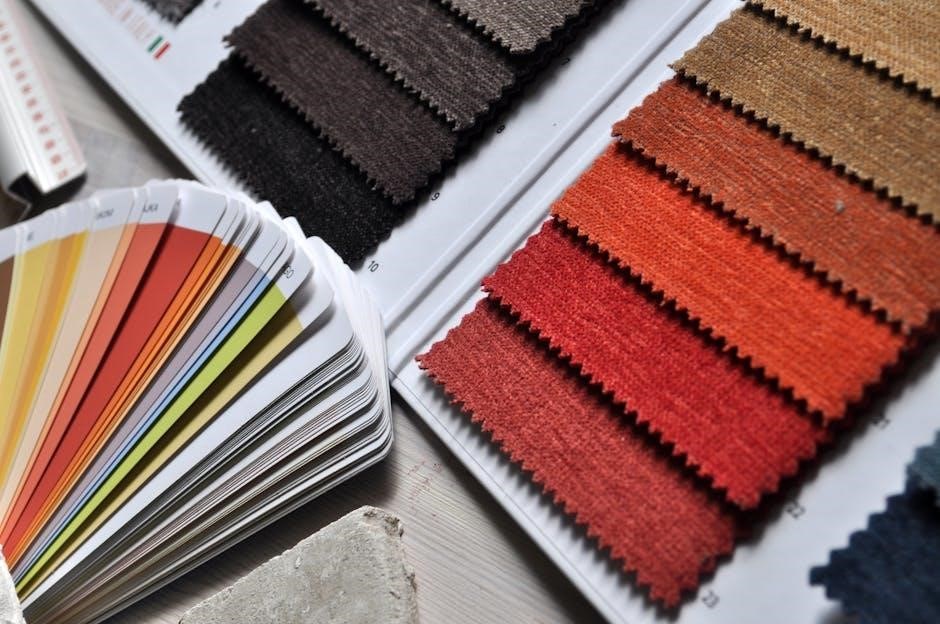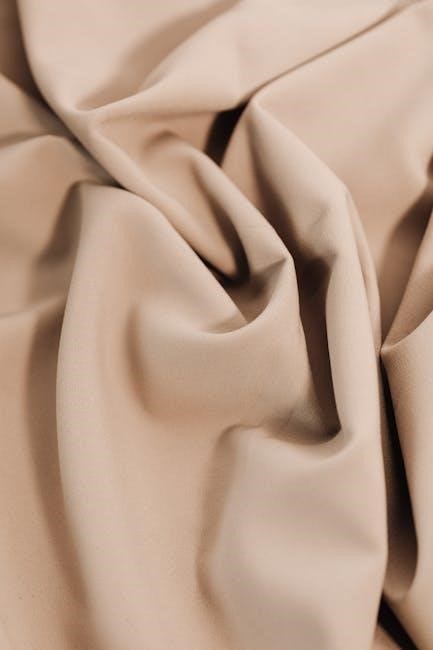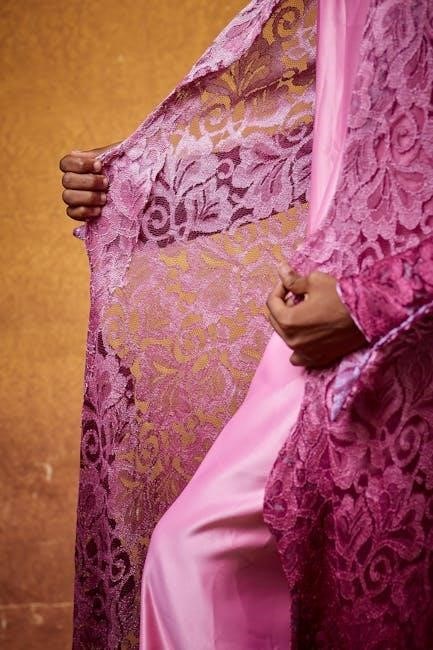The Reader’s Digest Complete Guide to Sewing is a comprehensive resource for sewers of all skill levels, offering detailed instructions and vibrant illustrations.
From basic techniques to advanced projects, this guide provides essential information on equipment, fabrics, and troubleshooting, making it an indispensable tool for every sewing enthusiast.
Overview of the Guide
The Reader’s Digest Complete Guide to Sewing is a detailed and organized resource designed for sewers of all skill levels, from beginners to advanced enthusiasts.
It covers a wide range of topics, including essential tools, fabric selection, basic and advanced techniques, and troubleshooting common mistakes, ensuring a well-rounded understanding of sewing.
Importance of Sewing Skills
Sewing is a practical and creative skill that empowers individuals to craft, repair, and customize clothing and home items, fostering self-sufficiency and sustainability.
It enhances problem-solving abilities, hand-eye coordination, and attention to detail, while also providing a therapeutic outlet for creativity and relaxation, making it a valuable skill for personal and professional growth.

Essential Equipment and Tools for Sewing
The right sewing tools are vital for success, from sewing machines and scissors to needles, threads, and notions, ensuring precision and versatility in every project.
Basic Sewing Machines and Their Features
Basic sewing machines are essential for beginners, offering mechanical or computerized options with straight and zigzag stitches. They often include adjustable stitch length and width, reverse stitching, and a free-arm feature for sewing cuffs or hemming pants. Some models come with built-in needle threaders and automatic tension, making them user-friendly. These machines are versatile for various projects, from repairs to crafting, suitable for all skill levels.
Hand Tools and Notions Every Sewer Needs
Essential hand tools include sharp scissors, rotary cutters, and precision tweezers for intricate tasks. Notions like pins, seam rippers, and tape measures are indispensable. Thimbles protect fingers, while embroidery hoops aid in stitching. Threads, buttons, zippers, and stabilizers are must-haves for various projects. These tools ensure accuracy, efficiency, and professional results, making them vital for every sewer’s workspace.
Setting Up Your Sewing Workspace
A well-organized sewing area enhances creativity and efficiency. Ensure good lighting with task lamps and natural light. Invest in a sturdy table for your machine and cutting activities. Store supplies like fabrics, threads, and notions in labeled bins or shelves. Keep essential tools within reach and maintain a clutter-free environment. An ironing station nearby streamlines workflow, making your workspace functional and enjoyable for all projects.

Basic Sewing Techniques

Master foundational sewing skills, from straight stitches to backstitching, ensuring strong, durable seams. Clear instructions guide you through fabric handling and essential techniques for every project.
Understanding Stitches and Their Applications
Mastering various stitches is fundamental to sewing success. The guide details straight stitches for seaming, backstitch for durability, and slipstitch for invisible closures. Each stitch’s purpose and application is explained with clear diagrams, ensuring sewers can choose the right technique for their projects. This section is designed to build confidence, whether you’re a beginner or an experienced sewer, by simplifying complex stitching processes.
Mastering Seams, Hems, and Edges
Seams, hems, and edges are the foundation of professional-looking garments. The guide offers step-by-step instructions for constructing strong, smooth seams and finishing edges neatly. Techniques like pressing, trimming, and using specialized tools are highlighted. Clear diagrams illustrate how to create perfect hems, from simple folded hems to decorative options. This section ensures a polished finish for every sewing project, elevating both functionality and aesthetics.
Working with Zippers and Buttons
Mastering zippers and buttons is essential for functional and attractive garments. The guide provides clear instructions for installing zippers smoothly and aligning buttons perfectly. Tips on choosing the right tools and techniques ensure secure fastening and professional finishes. Detailed diagrams help navigate common challenges, ensuring your projects look polished and last longer. This section is a must for achieving professional-grade results in your sewing.

Fabric Selection and Preparation
Fabric selection and preparation are crucial for successful sewing. Choose the right fabric type, understand grain and stretch, pre-treat materials, and cut accurately for professional results.
Choosing the Right Fabric for Your Project
Choosing the right fabric is essential for a successful sewing project. Consider the project’s purpose, durability needs, and care requirements. Natural fibers like cotton and linen are ideal for casual wear, while synthetic blends offer stretch and resilience. Seasonal fabrics, such as wool for winter or voile for summer, ensure comfort and practicality. Always match fabric type to the intended use for professional results and satisfaction.
Understanding Fabric Grain and Stretch
Fabric grain and stretch are crucial for successful sewing projects. Grain refers to the fabric’s warp thread direction, affecting stability and drape. Cutting on-grain prevents distortion, while off-grain can cause misshapen garments. Stretch varies; knits offer flexibility, ideal for fitted designs, while wovens provide structure. Aligning patterns with grain ensures proper fit and professional results, avoiding common sewing issues.
Pre-treating and Cutting Fabric
Pre-treating fabric ensures optimal results by removing finishes and pre-shrinking materials. Wash and dry fabric before cutting to prevent post-sewing shrinkage. Accurate cutting is vital; use tools like rotary cutters or sharp scissors for precision. Always match patterns to fabric grain to avoid distortion. Iron fabric before cutting to remove wrinkles, ensuring smooth, even cuts for professional-looking projects.

Patterns and Measurements
Understanding patterns and measurements is key to successful sewing. Learn to read patterns, take accurate body measurements, and alter patterns for a perfect fit every time.
Reading and Understanding Sewing Patterns
Reading sewing patterns requires understanding symbols, instructions, and fabric requirements. The guide simplifies this process with clear diagrams, ensuring even beginners can grasp the basics. It covers interpreting pattern markings, aligning fabric, and adjusting lengths. Detailed explanations help sewers decode instructions, while visual aids make complex steps manageable. This section is designed to build confidence in working with patterns, making sewing accessible and enjoyable for all skill levels.
Taking Accurate Body Measurements
Taking precise body measurements is crucial for achieving a perfect fit in sewing projects. The guide provides clear instructions on how to measure accurately, emphasizing the importance of using a flexible tape measure and keeping the tape level. It covers essential measurements, such as bust, waist, hips, and inseam, ensuring garments fit comfortably and flatter the body.
The section also includes tips for measuring challenging areas and offers advice on maintaining consistency. By following these guidelines, sewers can create garments that fit perfectly, enhancing both comfort and appearance. The guide ensures reliability and accuracy, making it easier to achieve professional results.
Altering Patterns for a Perfect Fit
The Reader’s Digest Complete Guide to Sewing offers a straightforward approach to altering patterns for a flawless fit. It provides detailed techniques for adjusting patterns based on body measurements, ensuring garments flatter every silhouette. From lengthening hems to adding darts, the guide delivers clear instructions and diagrams, making it easy to customize patterns for individual needs and achieve professional-looking results.

Advanced Sewing Techniques
The Reader’s Digest Complete Guide to Sewing explores advanced techniques like tailoring, embroidery, and working with specialized fabrics, helping sewers refine their skills for professional results.
Tailoring and Garment Construction
The Reader’s Digest Complete Guide to Sewing offers in-depth guidance on tailoring and garment construction, covering advanced techniques for creating custom-fit clothing. It provides detailed instructions on working with structured fabrics, drafting patterns, and mastering professional finishes. With clear diagrams and step-by-step instructions, sewers can refine their skills in crafting tailored jackets, precise collars, and flawless seams, ensuring high-quality, professional-grade results.
Embroidery and Decorative Stitching
The Reader’s Digest Complete Guide to Sewing includes a detailed section on embroidery and decorative stitching, offering step-by-step instructions for various stitches and techniques. It covers both hand and machine embroidery methods, with vibrant illustrations to guide sewers in creating intricate designs. Perfect for personalizing garments or home decor, this guide helps sewers master decorative elements, enhancing their projects with elegance and creativity.
Working with Specialized Fabrics
The Reader’s Digest Complete Guide to Sewing provides expert advice on handling specialized fabrics like silk, velvet, and stretch materials. It offers tips on cutting, stitching, and finishing to ensure professional results. The guide also covers troubleshooting common issues with delicate or unusual fabrics, helping sewers achieve flawless finishes and preserve fabric integrity for stunning, long-lasting projects.

Troubleshooting Common Sewing Mistakes
This section helps sewers identify and correct common errors, offering practical solutions for fabric distortion, tension issues, and seam repairs to ensure professional finishes.
Identifying and Fixing Fabric Distortion
Fabric distortion occurs when fabric stretches or skews during cutting or sewing, leading to misshapen seams and uneven hems. Common causes include incorrect cutting, uneven stretching, and insufficient stabilisation. To fix this, ensure fabric is properly aligned with grain lines, use staystitching on curved edges, and employ stabilising materials like interfacing. Pressing seams carefully and using the right tools can also help restore fabric shape and achieve professional results.
Adjusting Tension and Stitch Length
Proper tension and stitch length are crucial for even sewing. If stitches are too loose, increase tension; if too tight, decrease it. Adjusting these settings ensures consistent stitching, preventing fabric puckering or distortion. Use the machine’s dial to fine-tune tension and test on scrap fabric. Correct settings enhance stitch quality, making your projects look professional and ensuring durability. Always refer to your machine’s guide for specific instructions.
Repairing Seams and Hems
Repairing seams and hems is a common task that ensures longevity of garments. Start by identifying loose threads or gaps. Use a needle and thread to reinforcement stitch by hand or with a machine. For hems, carefully remove old stitches and reattach fabric evenly. The guide provides step-by-step methods to restore seams and hems seamlessly, preventing further damage and extending the life of your creations.

Projects for All Skill Levels
The Reader’s Digest Complete Guide to Sewing offers projects for every skill level, from simple home decor to intricate garments, supported by clear instructions and visuals.
Beginner-Friendly Projects
The Reader’s Digest Complete Guide to Sewing features a variety of beginner-friendly projects, such as simple pillowcases, tote bags, and basic clothing alterations. These projects are designed to help new sewers build confidence and master fundamental skills through clear, step-by-step instructions and detailed illustrations.
Each project is carefully crafted to be achievable, allowing beginners to learn essential techniques while creating practical and useful items. The guide’s emphasis on simplicity and clarity makes it an ideal starting point for anyone new to sewing.
Intermediate Sewing Challenges
The Reader’s Digest Complete Guide to Sewing offers intermediate projects that help sewers refine their skills, such as creating tailored skirts, shirts, and home decor items. These challenges introduce more complex techniques like working with zippers, buttons, and various fabrics, providing a smooth transition from basic to advanced sewing.
With detailed instructions and clear diagrams, the guide empowers intermediate sewers to tackle projects that require precision and patience, ensuring a strong foundation for future endeavors. Each challenge is designed to build confidence and mastery in sewing.
Advanced Sewing Projects
The Reader’s Digest Complete Guide to Sewing offers advanced projects for experienced sewers, including tailored garments, intricate embroidery, and complex home decor. These challenges involve precision techniques like pattern alterations and working with specialized fabrics, allowing sewers to showcase their mastery of advanced skills.
From custom-fit clothing to decorative stitching, these projects highlight the guide’s depth, providing detailed instructions for sewers aiming to refine their expertise and create professional-quality pieces.
The Reader’s Digest Complete Guide to Sewing is an indispensable resource for mastering sewing skills. With its detailed guidance, sewers of all levels can confidently create and continue exploring their creativity.
Final Thoughts on Sewing
The Reader’s Digest Complete Guide to Sewing stands as a timeless resource for sewers, offering unparalleled depth and clarity. Its comprehensive coverage of techniques, fabrics, and tools ensures that sewers of all levels can grow their skills with confidence. Whether you’re a beginner or an advanced sewer, this guide remains an essential companion for every project.
With its detailed troubleshooting tips, fabric selection insights, and vibrant illustrations, the guide empowers sewers to overcome challenges and create beautiful, professional-quality results. It’s a testament to the joy of sewing, inspiring creativity and precision in every stitch.
Encouragement to Continue Sewing
Embrace sewing as a lifelong skill that fosters creativity, practicality, and personal growth. With the Reader’s Digest Complete Guide to Sewing, you’ll gain the confidence to tackle any project, from simple repairs to intricate garments. Celebrate every stitch and remember that every piece you create is a testament to your dedication and artistry.
Don’t be afraid to experiment and explore new techniques. Sewing is a journey where mistakes are opportunities to learn and improve. Keep creating, and let the joy of sewing inspire you to craft something beautiful for yourself and others. Happy sewing!

